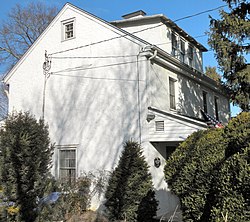플루시클로빈(18F)
Fluciclovine (18F) | |
| 임상자료 | |
|---|---|
| 상명 | 악슈민 |
| 라이센스 데이터 | |
| ATC 코드 | |
| 법적현황 | |
| 법적현황 |
|
| 식별자 | |
| |
| CAS 번호 | |
| 켐스파이더 | |
| 케그 | |
| 체비 | |
| 화학 및 물리적 데이터 | |
| 공식 | C5H818FNO2 |
| 어금질량 | 132.12 g/190 |
Fluciclovine (18F), also known as anti-1-amino-3-18F-fluorocyclobutane-1-carboxylic acid (anti-3[18F] FACBC),[1][2] or as Axumin (brand name), is a diagnostic agent indicated for positron emission tomography (PET) imaging in men with suspected prostate cancer recurrence based on elevated prostate specific antigen (PSA) levels.[3][4]null
배경
대부분의 영상검사들은 PSA가 약간 증가했을 때 재발하는 전립선암을 국소화시킬 수 없었다.[1][3]Axumin 스캔은 11[C] 태그가 붙은 콜린 PET 스캔과 비교되었고, FDA 승인 PET 스캔은 이러한 상황에 도움이 될 수 있으며 생체검사 결과와 비교되었다.[3][5]플루시클로빈 태그가 붙은 PET 스캔은 CT 스캔과[6] 11[C] 태그가 붙은 콜린 PET 스캔보다 더 민감하게 나타난다.[7][8]null
메커니즘
플루시클로빈(Fluciclovine)은 아미노산 L-루신(L-lucine)의 18[F] 태그가 붙은 합성 아날로그다.[9][10]종양에 의한 FASBC 흡수는 두 개의 아미노산 전달체,[11] 특히 나트륨 의존 시스템 ASC의 기능 활성과 관련이 있으며 나트륨 독립 시스템 L의 기여도가 낮다.[10]아미노산 전달체계에 의해 처리되지만, 체내에서 말기 기술대사를 거치지 않는다.[10]체내 추적기의 분포는 FACBC의 신장 흡수가 무시할 수 있고, 요로에서는 아무런 활동도 발견되지 않기 때문에 콜린과 FDG와 다르다.[10][11]FDG에 비해 토착 두뇌의 흡수율이 낮아서 뇌 전이나[2][10] 일차 뇌종양의 감지를 향상시킬 수 있다.[10]이 약물을 복용한 원주민 간 및 췌장 흡수가 더 강렬하게 관찰되면 이러한 장기에서 질병 감지를 제한할 것으로 예상된다.[10]FASBC는 합성 시간이 짧고 반감기가 길어서 현장 사이클로트론의 필요성이 없어진다.[11]null
마케팅
Axumin은 영국 블루 어스 진단사가 시판하고 있다.[4]null
참조
- ^ a b Schiavina R, Ceci F, Borghesi M, et al. (2013). "The dilemma of localizing disease relapse after radical treatment for prostate cancer: which is the value of the actual imaging techniques?". Curr Radiopharm. 6 (2): 92–5. doi:10.2174/1874471011306020005. PMID 23597246.
- ^ a b 포레스트 W. "스타트업은 전립선 PET 에이전트를 개발한다."AuntMinnie.com 2014년 5월 9일 [1]
- ^ a b c FDA 보도 자료."FDA는 재발 전립선암 검출을 위한 새로운 영상검사제를 승인한다." 2016년 5월 27일 [2]
- ^ a b Drugs.com "FDA, 2016년 5월 27일 재발 전립선암 검출을 위한 Axumin (Fluciclovine F 18) 진단 이미지 에이전트 승인 [3]
- ^ 베르베라베 T. "FDA, 재발 전립선암에 대한 방사선 촬영제 액스민 승인" 2016년 5월 27일 OncLive [4]
- ^ Odewole OA, Tade FI, Nieh PT, et al. (2016). "Recurrent prostate cancer detection with anti-3-[(18)F]FACBC PET/CT: comparison with CT". Eur. J. Nucl. Med. Mol. Imaging. 43 (10): 1773–1783. doi:10.1007/s00259-016-3383-8. PMC 4970909. PMID 27091135.
- ^ Evangelista L, Briganti A, Fanti S, et al. (2016). "New Clinical Indications for (18)F/(11)C-choline, New Tracers for Positron Emission Tomography and a Promising Hybrid Device for Prostate Cancer Staging: A Systematic Review of the Literature". Eur. Urol. 70 (1): 161–75. doi:10.1016/j.eururo.2016.01.029. PMID 26850970.
- ^ Nanni C, Schiavina R, Brunocilla E, et al. (2015). "18F-Fluciclovine PET/CT for the Detection of Prostate Cancer Relapse: A Comparison to 11C-Choline PET/CT". Clin Nucl Med. 40 (8): e386–91. doi:10.1097/RLU.0000000000000849. PMID 26053708. S2CID 31082439.
- ^ 뱅크헤드 C. "FDA 승인" MedPage Today, 2016년 5월 27일 [5]
- ^ a b c d e f g Schuster DM, Nanni C, Fanti S, et al. (2014). "Anti-1-amino-3-18F-fluorocyclobutane-1-carboxylic acid: physiologic uptake patterns, incidental findings, and variants that may simulate disease". J. Nucl. Med. 55 (12): 1986–92. doi:10.2967/jnumed.114.143628. PMC 4844004. PMID 25453047.
- ^ a b c Schiavina R, Brunocilla E, Martorana G (2014). "The new promise of FACBC position emission tomography/computed tomography in the localization of disease relapse after radical treatment for prostate cancer: are we turning to the right radiotracer?". Eur. Urol. 65 (1): 255–6. doi:10.1016/j.eururo.2013.08.053. PMID 24094575.
외부 링크
- "Fluciclovine". Drug Information Portal. U.S. National Library of Medicine.


